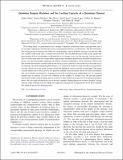| dc.contributor.author | Guha, Saikat | |
| dc.contributor.author | Hayden, Patrick | |
| dc.contributor.author | Krovi, Hari | |
| dc.contributor.author | Lloyd, Seth | |
| dc.contributor.author | Lupo, Cosmo | |
| dc.contributor.author | Shapiro, Jeffrey H. | |
| dc.contributor.author | Takeoka, Masahiro | |
| dc.contributor.author | Wilde, Mark M. | |
| dc.date.accessioned | 2014-08-25T15:52:53Z | |
| dc.date.available | 2014-08-25T15:52:53Z | |
| dc.date.issued | 2014-01 | |
| dc.date.submitted | 2013-11 | |
| dc.identifier.issn | 2160-3308 | |
| dc.identifier.uri | http://hdl.handle.net/1721.1/89024 | |
| dc.description.abstract | The locking effect is a phenomenon that is unique to quantum information theory and represents one of the strongest separations between the classical and quantum theories of information. The Fawzi-Hayden-Sen locking protocol harnesses this effect in a cryptographic context, whereby one party can encode n bits into n qubits while using only a constant-size secret key. The encoded message is then secure against any measurement that an eavesdropper could perform in an attempt to recover the message, but the protocol does not necessarily meet the composability requirements needed in quantum key distribution applications. In any case, the locking effect represents an extreme violation of Shannon’s classical theorem, which states that information-theoretic security holds in the classical case if and only if the secret key is the same size as the message. Given this intriguing phenomenon, it is of practical interest to study the effect in the presence of noise, which can occur in the systems of both the legitimate receiver and the eavesdropper. This paper formally defines the locking capacity of a quantum channel as the maximum amount of locked information that can be reliably transmitted to a legitimate receiver by exploiting many independent uses of a quantum channel and an amount of secret key sublinear in the number of channel uses. We provide general operational bounds on the locking capacity in terms of other well-known capacities from quantum Shannon theory. We also study the important case of bosonic channels, finding limitations on these channels’ locking capacity when coherent-state encodings are employed and particular locking protocols for these channels that might be physically implementable. | en_US |
| dc.description.sponsorship | United States. Defense Advanced Research Projects Agency. Quiness Program (United States. Army Research Office. Award W31P4Q-12-1-0019) | en_US |
| dc.description.sponsorship | United States. Office of Naval Research (Grant N000140811249) | en_US |
| dc.language.iso | en_US | |
| dc.publisher | American Physical Society | en_US |
| dc.relation.isversionof | http://dx.doi.org/10.1103/PhysRevX.4.011016 | en_US |
| dc.rights | Article is made available in accordance with the publisher's policy and may be subject to US copyright law. Please refer to the publisher's site for terms of use. | en_US |
| dc.source | American Physical Society | en_US |
| dc.title | Quantum Enigma Machines and the Locking Capacity of a Quantum Channel | en_US |
| dc.type | Article | en_US |
| dc.identifier.citation | Guha, Saikat, Patrick Hayden, Hari Krovi, Seth Lloyd, Cosmo Lupo, Jeffrey H. Shapiro, Masahiro Takeoka, and Mark M. Wilde. “Quantum Enigma Machines and the Locking Capacity of a Quantum Channel.” Physical Review X 4, no. 1 (January 2014). | en_US |
| dc.contributor.department | Massachusetts Institute of Technology. Department of Electrical Engineering and Computer Science | en_US |
| dc.contributor.department | Massachusetts Institute of Technology. Department of Mechanical Engineering | en_US |
| dc.contributor.department | Massachusetts Institute of Technology. Research Laboratory of Electronics | en_US |
| dc.contributor.mitauthor | Lloyd, Seth | en_US |
| dc.contributor.mitauthor | Lupo, Cosmo | en_US |
| dc.contributor.mitauthor | Shapiro, Jeffrey H. | en_US |
| dc.relation.journal | Physical Review X | en_US |
| dc.eprint.version | Final published version | en_US |
| dc.type.uri | http://purl.org/eprint/type/JournalArticle | en_US |
| eprint.status | http://purl.org/eprint/status/PeerReviewed | en_US |
| dspace.orderedauthors | Guha, Saikat; Hayden, Patrick; Krovi, Hari; Lloyd, Seth; Lupo, Cosmo; Shapiro, Jeffrey H.; Takeoka, Masahiro; Wilde, Mark M. | en_US |
| dc.identifier.orcid | https://orcid.org/0000-0002-5227-4009 | |
| dc.identifier.orcid | https://orcid.org/0000-0002-6094-5861 | |
| mit.license | PUBLISHER_POLICY | en_US |
| mit.metadata.status | Complete | |
